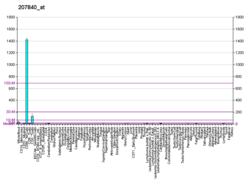Protein-coding gene in the species Homo sapiens
CD160 antigen is a protein that in humans is encoded by the CD160 gene .[ 5] [ 6] [ 7]
CD160 is a 27 kDa glycoprotein which was initially identified with the monoclonal antibody BY55. Its expression is tightly associated with peripheral blood NK cells and CD8 T lymphocytes with cytolytic effector activity. The cDNA sequence of CD160 predicts a cysteine-rich, glycosylphosphatidylinositol-anchored protein of 181 amino acids with a single Ig-like domain weakly homologous to KIR2DL4 molecule. CD160 is expressed at the cell surface as a tightly disulfide-linked multimer. RNA blot analysis revealed CD160 mRNAs of 1.5 and 1.6 kb whose expression was highly restricted to circulating NK and T cells, spleen and small intestine. Within NK cells CD160 is expressed by CD56dimCD16+ cells whereas among circulating T cells its expression is mainly restricted to TCRgd bearing cells and to TCRab+CD8brightCD95+CD56+CD28-CD27-cells. In tissues, CD160 is expressed on all intestinal intraepithelial lymphocytes. CD160 shows a broad specificity for binding to both classical and nonclassical MHC class I molecules.[ 7]
Clinical significance [ edit ] CD160 is a ligand for HVEM , and considered a proposed immune checkpoint inhibitor with anti-cancer activity along with anti- PD-1 antibodies.[ 8] [ 9]
^ a b c GRCh38: Ensembl release 89: ENSG00000117281 – Ensembl , May 2017^ a b c GRCm38: Ensembl release 89: ENSMUSG00000038304 – Ensembl , May 2017^ "Human PubMed Reference:" . National Center for Biotechnology Information, U.S. National Library of Medicine .^ "Mouse PubMed Reference:" . National Center for Biotechnology Information, U.S. National Library of Medicine .^ Anumanthan A, Bensussan A, Boumsell L, Christ AD, Blumberg RS, Voss SD, et al. (September 1998). "Cloning of BY55, a novel Ig superfamily member expressed on NK cells, CTL, and intestinal intraepithelial lymphocytes" . Journal of Immunology . 161 (6): 2780–2790. doi :10.4049/jimmunol.161.6.2780 PMID 9743336 . S2CID 25536877 . ^ Agrawal S, Marquet J, Freeman GJ, Tawab A, Bouteiller PL, Roth P, et al. (February 1999). "Cutting edge: MHC class I triggering by a novel cell surface ligand costimulates proliferation of activated human T cells" . Journal of Immunology . 162 (3): 1223–1226. doi :10.4049/jimmunol.162.3.1223 PMID 9973372 . S2CID 23169904 . ^ a b "Entrez Gene: CD160 CD160 molecule" .^ Stecher C, Battin C, Leitner J, Zettl M, Grabmeier-Pfistershammer K, Höller C, et al. (22 May 2017). "PD-1 Blockade Promotes Emerging Checkpoint Inhibitors in Enhancing T Cell Responses to Allogeneic Dendritic Cells" . Frontiers in Immunology . 8 : 572. doi :10.3389/fimmu.2017.00572 PMC 5439058 PMID 28588576 . ^ Chabot S, Jabrane-Ferrat N, Bigot K, Tabiasco J, Provost A, Golzio M, et al. (May 2011). "A novel antiangiogenic and vascular normalization therapy targeted against human CD160 receptor" . The Journal of Experimental Medicine . 208 (5): 973–986. doi :10.1084/jem.20100810 . PMC 3092350 PMID 21482699 . ^ Klopocki E, Schulze H, Strauss G, Ott CE, Hall J, Trotier F, et al. (February 2007). "Complex inheritance pattern resembling autosomal recessive inheritance involving a microdeletion in thrombocytopenia-absent radius syndrome" . American Journal of Human Genetics . 80 (2): 232–240. doi :10.1086/510919 . PMC 1785342 PMID 17236129 . Bensussan A, Gluckman E, el Marsafy S, Schiavon V, Mansur IG, Dausset J, et al. (September 1994). "BY55 monoclonal antibody delineates within human cord blood and bone marrow lymphocytes distinct cell subsets mediating cytotoxic activity" . Proceedings of the National Academy of Sciences of the United States of America . 91 (19): 9136–9140. Bibcode :1994PNAS...91.9136B . doi :10.1073/pnas.91.19.9136 PMC 44762 PMID 8090781 . Nikolova M, Marie-Cardine A, Boumsell L, Bensussan A (May 2002). "BY55/CD160 acts as a co-receptor in TCR signal transduction of a human circulating cytotoxic effector T lymphocyte subset lacking CD28 expression" . International Immunology . 14 (5): 445–451. doi :10.1093/intimm/14.5.445 PMID 11978774 . Tanaka J, Toubai T, Tsutsumi Y, Miura Y, Kato N, Umehara S, et al. (August 2004). "Cytolytic activity and regulatory functions of inhibitory NK cell receptor-expressing T cells expanded from granulocyte colony-stimulating factor-mobilized peripheral blood mononuclear cells" . Blood . 104 (3): 768–774. doi :10.1182/blood-2003-11-3870 PMID 15073036 . Barakonyi A, Rabot M, Marie-Cardine A, Aguerre-Girr M, Polgar B, Schiavon V, et al. (November 2004). "Cutting edge: engagement of CD160 by its HLA-C physiological ligand triggers a unique cytokine profile secretion in the cytotoxic peripheral blood NK cell subset" . Journal of Immunology . 173 (9): 5349–5354. doi :10.4049/jimmunol.173.9.5349 PMID 15494480 . Abecassis S, Giustiniani J, Meyer N, Schiavon V, Ortonne N, Campillo JA, et al. (May 2007). "Identification of a novel CD160+ CD4+ T-lymphocyte subset in the skin: a possible role for CD160 in skin inflammation" . The Journal of Investigative Dermatology . 127 (5): 1161–1166. doi :10.1038/sj.jid.5700680 PMID 17218942 . Giustiniani J, Marie-Cardine A, Bensussan A (February 2007). "A soluble form of the MHC class I-specific CD160 receptor is released from human activated NK lymphocytes and inhibits cell-mediated cytotoxicity" . Journal of Immunology . 178 (3): 1293–1300. doi :10.4049/jimmunol.178.3.1293 PMID 17237375 .
1–50 51–100 101–150 151–200 201–250 251–300 301–350


 French
French Deutsch
Deutsch



